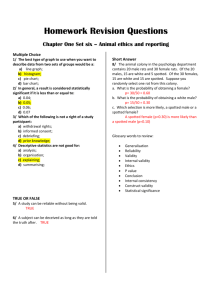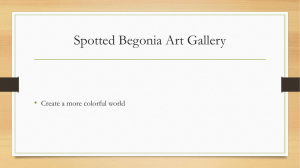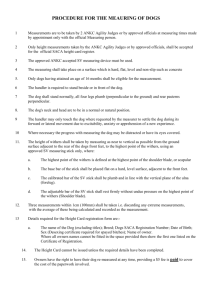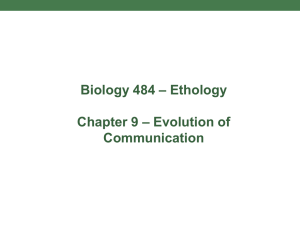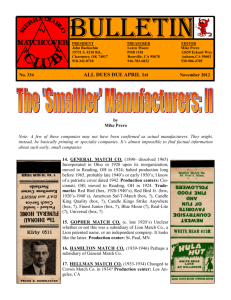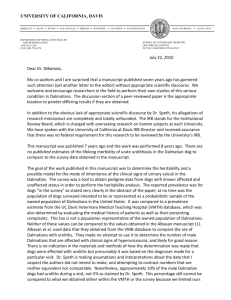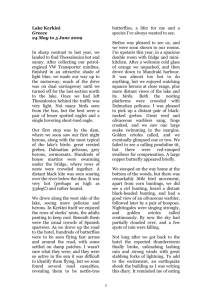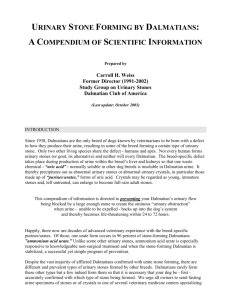dalmatian
advertisement
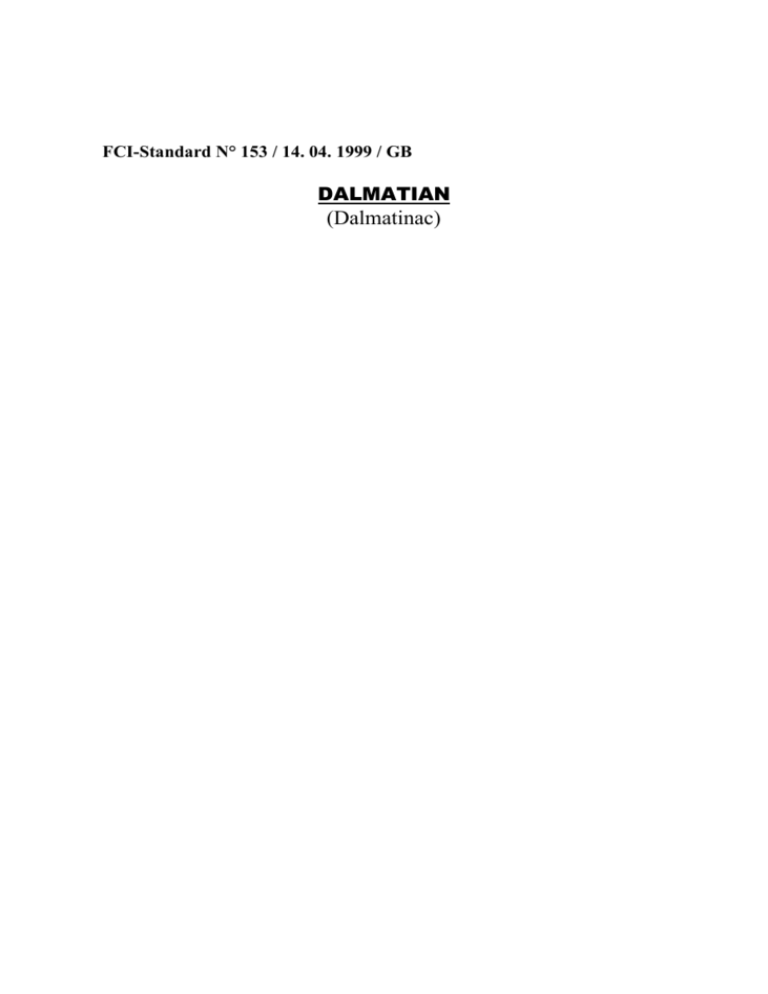
FCI-Standard N° 153 / 14. 04. 1999 / GB DALMATIAN (Dalmatinac) 2 TRANSLATION : A.J.E.Beekes and Mrs.R.Binder. ORIGIN : Dalmatia, Croatian Republic. DATE OF PUBLICATION OF THE ORIGINAL VALID STANDARD : 14.04.1999. UTILIZATION : Companion dog, family dog, suitable to be trained for various purposes. CLASSIFICATION F.C.I. : Group 6 Scenthounds and related breeds. Section 3 Related breeds. Without working trial. BRIEF HISTORICAL SUMMARY : The origin of the Dalmatian dog is still obscure and rests solely on suppositions. From illustrations, discovered in the tombs of ancient Pharaohs and similar to paintings dating back to the period from the 16th to the 18th century, one can suppose that the Dalmatian has been in existence for some thousands of years. Church chronicles from the 14th century and from the year 1719 definitely suggest that the breed originated in the Mediterranean region and especially in the neighbourhood of the Dalmatian coast. The earliest illustrations of the breed can be found in pictures by Italian painters of the 16th century and in a fresco in Zaostrog (Dalmatia) that can be dated back to the year 1710 approximately. A work by Thomas Bewick, published in 1792, contains a description and the drawing of a Dalmatian, which Bewick refers to as « the Dalmatian or coach Dog ». The first standard for the Dalmatian was written by an Englishman named Vero Shaw in the year 1882; in 1890 this standard was transferred to the official breed standard. GENERAL APPEARANCE : The Dalmatian is a well balanced, distinctively spotted, strong, muscular and active dog. Symmetrical in outline, free from coarseness and lumber, and as a former « coach dog » capable of great endurance at a fair turn of speed. FCI-St n° 153 3 IMPORTANT PROPORTIONS : Length of the body : height at the withers = approximately 10 : 9. Length of skull : length of muzzle = 1 : 1. BEHAVIOUR / TEMPERAMENT : Outgoing and friendly, not shy or hesitant, free from nervousness and aggression. HEAD : Of fair length. CRANIAL REGION : Skull : Flat, fairly broad between the ears, with well defined temples. Slight frontal furrow. Entirly free from wrinkle. Stop : Moderately well defined. FACIAL REGION : Nose : Nose leather in the black spotted variety always black, in the liver spotted variety always brown. Muzzle : Long, powerful, never snipy. Nasal bridge straight and parallel to the upper outline of the skulll. Lips : Clean, fitting the jaw rather closely, not pendulous. A complete pigmentation is desired. Jaws/Teeth : Jaws strong with a perfect and regular scissor bite, i.e. upper teeth closely overlapping lower teeth and set square to the jaws. Desirable is a complete set of 42 teeth (in accordance with the teeth formula). The teeth are evenly proportioned and white. Eyes : Set moderately well apart, medium size, round, bright and sparkling with an intelligent and alert expression. Colour dark brown in black spotted, light brown to amber in liver spotted dogs. Eye rims completely black in the black spotted, and completely liver brown in the liver spotted dogs. Eyelid close to the eyeball. Ears : Set on rather high, moderate size, rather wide at base. Carried close to the head, gradually tapering to rounded point. Fine in texture, marking well broken up, preferably spotted. NECK : Fairly long, nicely arched, tapering to the head, free from throatiness. FCI-St n° 153 4 BODY : Withers : Well defined. Back : Powerful, level. Loins : Clean, muscular and slightly arched. Croup : Very slightly sloping. Chest : Not too broad, but deep and capacious. Brisket should reach to the elbows. Forechest well visible in profile. Ribs well proportioned, long, nicely sprung, never flat, barrel-shaped or malformed. Flanks : Narrow. Lower line : Belly distinctly tucked up towards the loin. TAIL : Reaching approximately to the hock. Strong at the base, evenly tapering towards the tip; free from coarseness. Inserted neither too low nor too high. At rest carried pendent with a slight upward curve in the lowest third of the tail. When moving carried higher slightly above the topline, but never upright (gay) or curled. Preferably spotted. LIMBS FOREQUARTERS : Forelegs perfectly straight, with strong round bone down to feet. Shoulders : Moderately oblique, clean and muscular. Elbows : Close to the body, neither turned in nor out. Pastern joint : Strong, with slight spring. HINDQUARTERS : Rounded, muscular, clean. Viewed from the rear hindlegs vertical and parallel. Stifle : Well bent. Lower thigh : Strong. Hock joint : Strong, well bent. FEET : Round, compact with well arched toes (cat feet). Pads round, tough and elastic. Nails black or white in black spotted variety; in liver spotted brown or white. FCI-St n° 153 5 GAIT/MOVEMENT : Great freedom of movement. Smooth, powerful, rhythmic action with long stride and good drive from hindquarters; viewed from the rear legs moving parallel, hindlegs tracking the fore. A short stride and paddling action are incorrect. COAT HAIR : Short, hard, dense, sleek and glossy. COLOUR : Ground colour pure white. Black spotted variety with black spots, liver spotted variety with brown spots; not intermingling but round, well defined and as well distributed as possible. Size 2-3 cm in diameter. Spots on the head, tail and extremities smaller than those on the body. SIZE AND WEIGHT : Overall balance of prime importance. Height at withers : For dogs 56-61 cm. For bitches 54-59 cm. Weight : For dogs approximately 27-32 kg, For bitches approximately 24-29 kg. FAULTS : Any departure from the foregoing points should be considered a fault and the seriousness with which the fault should be regarded should be in exact proportion to its degree. Bronzing (tempory bronze-like discolouring of the black spots). ELIMINATING FAULTS : Aggresive or overly shy. Definitely over-or undershot mouth. Ectropion, entropion; wall eye, eyes of different colour (heterochromia). Blue eyes. Deafness. Limited patching around eyes (monocle) or elsewhere, yet acceptable for breeding). Tricolour (black and brown spots on the same dog). FCI-St n° 153 6 Lemon (lemon or orange spots). Very timid or aggressive behaviour. Any dog clearly showing physical or behavioural abnormalities shall be disqualified. N.B. : Male animals should have two apparently normal testicles fully descended into the scrotum. RECOMMENDATION : In order to reduce the incident of deafness in Dalmatians (20-30%). Bilaterally deaf Dalmatians and blue-eyed Dalmatians should be discarded from breeding, ideally unilaterally deaf dogs likewise. Dogs with limited patching around eyes (monocle) or elsewhere should be accepted for breeding. Dogs with pigmented scrotum should be preferred. FCI-St n° 153
